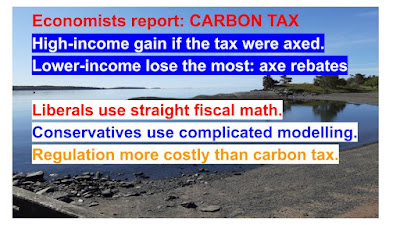Laura Osman of the Canadian Press, in an article in the Globe and Mail notes that every province and territory in Canada has been subject to a carbon price since 2019, with a choice between enacting their own version that meets federal standards or using a federal program. Most use the federal version for consumers and small businesses, while most have their own system for big industry. Conservative Leader Pierre Poilievre has promised to make the carbon price the central issue in the next election.
Economist Chris Ragan, director of the Max Bell School of Public Policy at McGill University, who helped draft an open letter defending the policy comments that:
“The issue has clearly been heating up,... The quality of the debate, I think, is not quite as good as it should be.” (Osman, n.d.)
Ragan said he hopes the economists’ letter better informs that debate, and gives ammunition to politicians who are defending the policy. Ultimately he wants to see the carbon price become politically mainstream.
While the main political criticism of the program is the cost to consumers, the economists say a carbon price is actually the least costly way to lower emissions.
“Other methods, such as direct regulations, tend to be more intrusive and inflexible, and cost more,” the letter states. (Osman, n.d.)
Canadian economists have released an open letter to add professional knowledge to the important discussion of the role of carbon tax in reducing GHG emissions in our efforts to mitigate the effects of climate change. Five claims by carbon tax critics are addressed by presenting evidence.
Claim #1: Carbon pricing won’t reduce GHG emissions.
Evidence shows it reduces GHG emissions at a lower cost than other approaches. The Canadian Climate Institute shows that federal and provincial carbon pricing, for industries and consumers, is expected to account for almost half of Canada’s emissions reductions by 2030. Carbon pricing is the lowest cost approach because it gives each person and business the flexibility to choose the best way to reduce their carbon footprint. Other methods, such as direct regulations, tend to be more intrusive and inflexible, and cost more. (An Open Letter From Economists on Canadian Carbon Pricing, n.d.)
Claim #2: Carbon pricing drives up the cost of living and is a major cause of inflation.
Evidence shows that Canadian carbon pricing has a negligible impact on overall inflation. According to the Bank of Canada, carbon pricing has caused less than 1/20th of Canada’s inflation in the past two years. Most families receive more money in rebates than they pay in carbon pricing, particularly those with low or medium incomes. (An Open Letter From Economists on Canadian Carbon Pricing, n.d.)
Claim #3: It makes little sense to have both a carbon price and rebates.
Evidence shows that the price-and-rebate approach provides an incentive to reduce carbon emissions (due to the price), while maintaining most households’ overall purchasing power (due to the rebate). Carbon pricing works by raising the price of carbon-intensive products, so consumers and businesses are incentivized to adopt lower-carbon options, such as smart thermostats, heat pumps, or hybrid/electric vehicles. Those that reduce emissions the most will come out further ahead; they will pay less in carbon fees but still get the full rebate. (An Open Letter From Economists on Canadian Carbon Pricing, n.d.)
Claim #4: Carbon pricing harms Canadian business competitiveness.
The output-based system is designed to maintain industries’ competitiveness: ensuring that the carbon price does not hamper their ability to stay profitable and generate jobs in Canada while competing internationally. In addition, carbon pricing stimulates innovation by encouraging the development and adoption of low-carbon technologies. These incentives help Canadian businesses—in all sectors—stay competitive in the global transition to a low-carbon economy. (An Open Letter From Economists on Canadian Carbon Pricing, n.d.)
Claim #5: Carbon pricing isn’t necessary.
Canada has many economic challenges to address. In a world of scarce resources, it seems imprudent to abandon carbon pricing, only to replace it with more costly methods of reducing emissions—or, worse still, take no measures to reduce emissions. In short, carbon pricing is the least-cost way to reduce emissions, drive green innovation, and support Canada’s transition to a clean and prosperous economic future. (An Open Letter From Economists on Canadian Carbon Pricing, n.d.)
Skilled tradespeople are employed to do serious construction and maintenance. Health Professionals are charged with our well being. Economists have the expert skill to assess the effect of climate change policy on our financial situation and future well being of Canada in a low carbon economy.
References
An Open Letter from Economists on Canadian Carbon Pricing. (n.d.). Retrieved March 27, 2024, from https://sites.google.com/view/open-letter-carbon-pricing
Osman, L. (n.d.). Economists defend Liberals’ carbon price as political rhetoric heats up. Wikipedia. Retrieved March 27, 2024, from https://www.theglobeandmail.com/business/article-economists-defend-liberals-carbon-price-as-political-rhetoric-heats-up/






